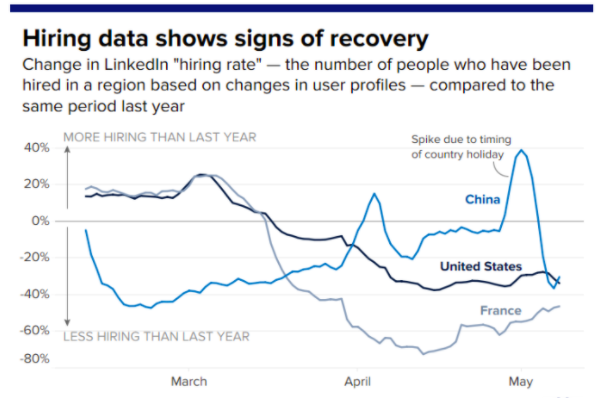The layoffs in the United States are slowing down. What about the people who have been laid off?
Editor’s note: This article “Silicon Valley insight” from the public micro-channel number (ID: guigudiyixian) , Author: Silicon Valley Insight.
(This article is jointly produced by Tencent Technology and Silicon Valley Insight, and the first release of the Tencent News client is unauthorized, please do not reprint)
Since the epidemic spread globally, the United States has also fallen into a massive layoffs. From March to the end of May, the number of Americans applying for unemployment benefits reached 41 million. The nationwide unemployment rate rose from 4.4% in March to 14.7% in April, the highest since the Great Depression. Many economists predict that the unemployment rate may be close to 20% in May.
As a US technology center, many companies in Silicon Valley are also caught in the layoffs. Unicorn companies such as Airbnb, Lyft and Yelp and hundreds of smaller technology companies have been involved. According to data, since early March, about 430 companies have laid off more than 50,000 employees, and Uber alone has laid off more than 6,000 employees.
Behind the layoffs in Silicon Valley are live individuals and even families, the pictures come from the Internet
Behind the cold unemployment data, there are live individuals. Many people come to Silicon Valley with dreams to become “silicon drift”, and to the outside world, many people working in Silicon Valley enjoy a healthy lifestyle, comfortable climate and decent work. But in today’s situation, these “dream chasers” have to face struggle and confusion in this global disaster. In the “layoffs,” some people fled Silicon Valley; some put their dreams on hold; others found new directions in despair.
20-year-old “silicon drift”: finally escaped from Silicon Valley
In the afternoon of late April, Lime’s current CEO Brad Bao sent an email to his employees: “I’m sorry, we have no choice but to say goodbye to about 80 employees “McLaughlin, 40, is one of these 80 people. And the night before, he was stillTogether, he celebrated the progress of his younger son’s cancer treatment.
McLaughlin, who was laid off, was an old “silicon drifter” who moved to the Bay Area 20 years ago. Prior to this outbreak, he had also experienced Uber’s layoffs.
In early 2018, after McLaughlin sold the tour guide company he founded, he found an operational job in Uber’s shared bicycle travel department. “In the second month of Uber, my youngest son was diagnosed with malignant cancer, which made my life very difficult. In the fall of the same year, Uber began to lay off a large number of employees in the shared bicycle department.” McLaughlin told reporters, “After being laid off by Uber, I had to quickly find a new job to pay for my son’s medical expenses, so I came to Lime.”
Tim McLaughlin and his son, picture from The Information
McLaughlin loves Lime’s work very much. He is part of a team of operations managers. This team consists of thousands of shared bicycles and electric vehicles in Auckland and is responsible for supervising the operations team.
In early March of this year, after the coronavirus outbreak, Lime shut down all shared mobility devices. When the company has almost no income, this has forced executives to find ways to lay off employees to ensure that the company can survive. But McLaughlin always believed that he would not be fired because he made a significant contribution to the internal data analysis tools that the company was developing.
McLaughlin, now laid off by two travel companies, is struggling to find a new job. He said in an interview: “Working in a company without a clear business model is a very risky thing. Working in such a company must be prepared for the best and worst. But if I can’t find it quickly For a new job, I would consider moving to a cheaper city, close to a good children’s hospital. And, I might want to start my own business and control my destiny more.”
Dream broken: I wanted to buy the cheapest house in the Bay Area
In addition to the 20-year-old “silicon drift” like McLaughlin, it has been used by Apple, Google, Fa in the past ten yearsThe new “silicon drift” attracted by cebook is also countless. Most of them are between 25-35 years old. They just came to this area with the dream of becoming the next Jobs or Zuckerberg after graduating from university. In order to attract these enthusiastic and talented young people, start-up companies in Silicon Valley will also offer very generous salaries and benefits.
Everyone who comes to Silicon Valley wants to be the next Jobs, the picture is from the promotional photo of the American drama “Silicon Valley”
25-year-old Sharissa Staples is one of the young people who was attracted to Silicon Valley. Staples said: “I am the first person in my family to go to university, majoring in history and ethnic studies. As I get older, I will become more and more clear about what I want, and my dream Need to be realized in Silicon Valley.” So she resolutely moved to Silicon Valley.
In January last year, Staples joined the rental startup Zeus Living. She is the second employee of this company, helping the company grow from about 90 people to nearly 300 people. In December last year, the company received $55 million in investment from outside investors such as Airbnb and Comcast. But with the outbreak of the epidemic, tourism has also been hit hard. Zeus laid off a third of its employees in March, including Staples.
“After being laid off, I had to apply for relief from the government. However, nearly two months after I submitted my application, I received unemployment benefits. Although this relief can help me through a difficult time But now I need to find a new job the most. This is really difficult.”
Startups have fallen like dominoes, and even big companies like Google and LinkedIn have said they will reduce the number of recruits this year or suspend recruitment because they are preparing for a long-term downturn.
This has caused the competition in the job market to become extremely fierce. Staples said: “It is very difficult for you to compete with so many talented people.”
At present, Staples, who is unemployed at home, has returned to his hometown. She had to look for work online while caring for her elderly grandparents: “My dream is to buy a cheapest house in the Bay Area, but now it seems that this dream may be over.”
Not waiting for unemployment benefits
Like people in Silicon Valley, other cities in the United States are also experiencing layoffs.
Giulia Umile (Philadelphia Umile) in Philadelphia used to be the COO of a boutique advertising company, and her job losses caused her to lose her job. After being unemployed, Umir started to help a company called CrossFit to do part-time customer training online, but such work could not help her support her family’s expenditure.
Umir also applied for unemployment benefits from the government, but two months later, the “life-saving money” has not arrived. Despite the hard times, Umier still cried and told reporters: “I will still keep looking for new employment opportunities. I don’t want to give up hope in life. I believe that as long as I persist, I will succeed.”
Someone was lucky to find a new job. For example, Emily Harris of Boston, she joined restaurant software company Toast in 2017 as a product analyst. For three years, Toast has been expanding at an alarming rate and has sufficient external investment. Its valuation has soared from about $500 million to nearly $4 billion, and the number of employees has more than tripled to more than 2,000. In 2019, its revenue has more than doubled, and it can be described as a rapid development.
Sharissa Staples (l.), Emily Harris, picture from Theinformation
However, under the epidemic, Harris still lost the job and her part-time job in the choir. Harris’ husband also lost his alcohol sales job.
“In order to save money, I had to start buying some cheap food online while changing my other lifestyle habits. When I received an alert that iCloud was running low on storage space, I spent two hours on my phone Manually delete one image after another, instead of paying $3 for additional space.” This kind of life completely changed Harris’s concept of money. “I no longer think of money as money, I see it as me. Dependence to survive these weeks.” But the good news is that Harris (Harris) received an offer from a digital marketing startup in early May as a marketing operation. andAnd she has accepted this hard-won offer.
10 years of technology industry recruitment hot end
As the layoffs of various companies reached their peak in March, layoffs in the United States have slowed since April. According to the recruitment activity data on LinkedIn analysis platform, it is found that the recruitment rate of American companies began to drop sharply from March. By April 15, the recruitment rate had dropped by nearly 38% compared with the previous year. But after that, the rate of decline began to flatten. In addition, the number of people receiving unemployment assistance is also decreasing. In the week of May 24, 2.1 million people applied for unemployment assistance. In March, the maximum weekly unemployment assistance reached 6.9 million.
The latest data from LinkedIn shows that as of May 8, the US recruitment rate fell by nearly 34% year-on-year, better than the decline in April. But LinkedIn chief economist Karin Kimbrough said that although the US recruitment rate seems to have stabilized, the road to recovery may be long and slow.
Picture: LinkedIn uses 7 days as the statistical period to count the position changes of user pages on its own platform; data As of May 8, 2020
The layoffs ended the 10-year recruitment boom in the technology industry. According to data from the Silicon Valley Institute for Regional Studies based on US census data, in 2018 alone, more than 50,000 young people between the ages of 25 and 44 came to Silicon Valley to work in technology Be aware that this number exceeds the combined total of Seattle and New York immigrants. Over the past decade, the employment rate in San Francisco and Silicon Valley has been growing at two to three times the national average.
Although the growth rate of the unemployment rate has slowed down, it does not mean that the people who are laid off will soon regain their job opportunities. Due to the large-scale closure of the enterprise, the unemployed employees have to stay at home or pay The government claims unemployment benefits.
The current situation is even more difficult for startups. Startup companies often do not have sufficient funds to deal with such risks. The severance pay provided to laid-off employees is only equivalent to a few weeks’ salary, and many employees are suddenly notified of layoffs. This has resulted in many people having to fight nowFind a new job to pay for medical expenses, rent and other living expenses.
Dream chasing has never been an easy task. Perhaps the Silicon Valley you see in movies or American dramas is high-end, atmospheric, and high-end, but in fact, there is no difference between Silicon Valley and Beishangguang. , They are eager to become the next Jobs and Zuckerberg, they represent the dream of this era, but also represent the dream break. Countless people came to big cities with unwillingness to be ordinary, and experienced countless sadness and tears for their dreams.
China also had countless “North Drift”, “Shanghai Drift” and “Yue Drift” in the period when the epidemic was the worst. We faced the problem of being laid off and the company closed down. The haze of the epidemic has dispersed. Although the process is extremely painful, Xiao Tan believes that people affected by the epidemic in all corners of the world will be able to persevere. The world after the epidemic will be more exciting.




